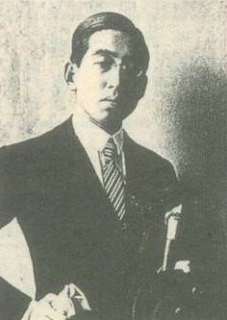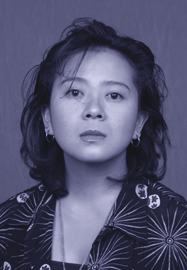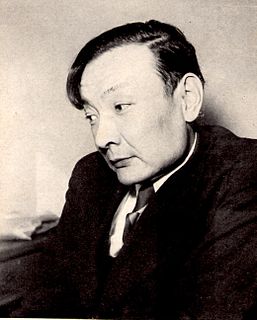 W
WAnjirō (アンジロー) or Yajirō , baptized as Paulo de Santa Fé, was the first recorded Japanese Christian, who lived in the 16th century. After committing a murder in his home domain of Satsuma in southern Kyushu, he fled to Portuguese Malacca and he sought out Saint Francis Xavier (1506–1552) and returned to Japan with him as an interpreter. Along with Xavier, Anjirō returned to Japan with two other Jesuits, two Japanese companions, and a Chinese companion who had been baptized to Catholicism to form the first Jesuit mission to Japan.
 W
WIkuma Arishima was the pen-name of Arishima Mibuma, a Japanese novelist and painter active in the Taishō and Shōwa period. He also used Utosei and then Jugatsutei as alternative pen names.
 W
WYukie Chiri was a Japanese transcriber and translator of Yukar.
 W
WTsuneari Fukuda was a Japanese dramatist, translator, and literary critic. From 1969 until 1983, he was a professor at Kyoto Sangyo University. He became a member of the Japan Art Academy in 1981.
 W
WFukuzawa Yukichi was a Japanese author, writer, teacher, translator, entrepreneur, journalist, and leader who founded Keio University, Jiji-Shinpō and the Institute for Study of Infectious Diseases.
Tsuruko Haraguchi was a Japanese psychologist and the first Japanese woman to receive a Doctor of Philosophy.
 W
WKazuo Hirotsu was a Japanese novelist, literary critic and translator active in the Shōwa period.
 W
WJūran Hisao was the pen-name of a Japanese author of popular fiction in Shōwa period Japan. Hisao Jūran was a pioneer in the use of black humor in Japanese literature. His works reflect his extensive knowledge of a wide range of subjects, and displayed extraordinary skills, and range from mystery tales to humor, and both historical and contemporary settings. His real name was Masao Abe .
 W
WHanako, Princess Hitachi , is a member of the Japanese Imperial Family as the wife of Masahito, Prince Hitachi, who is the younger son of Emperor Shōwa and the only brother of the retired emperor Akihito.
 W
WTatsuo Hori was a writer, poet, and translator in Shōwa period Japan.
 W
WDaigaku Horiguchi was a poet and translator of French literature in Taishō and Shōwa period Japan. He is credited with introducing French surrealism to Japanese poetry, and to translating the works of over 66 French authors into Japanese.
 W
WNoriko Ibaragi was a Japanese poet, playwright, essayist, children's literature writer, and translator. She is most well known for her poem, Watashi ga ichiban kirei datta toki , written twelve years after the Japanese defeat in WWII. In 1953, she co-founded the literary journal Kai ("Oars"). She began to learn Korean as a second language at the age of fifty, going on to publish her own translations of poetry by her Korean contemporaries.
 W
WIkuta Chōkō was the pen-name of a noted translator, author and literary critic in Taishō and Shōwa period Japan. His real name was ’Ikuta Kōji’ .
 W
WJun Ishikawa was the pen name of a modernist author, translator and literary critic active in Shōwa period Japan. His real name was Ishikawa Kiyoshi.
 W
WSei Itō a.k.a. Hitoshi Itō was a Japanese poet, novelist, and translator.
 W
WKiyoshi Jinzai was a Japanese novelist, Russian translator and literary critic active during the Shōwa period of Japan.
 W
WŌmi Komaki was the pen-name of a scholar and translator of French literature in Taishō and Shōwa period Japan. His real name was Komaki Ōmiya.
 W
WHidemi Kon was a literary critic and essayist active in Japan during the Shōwa period.
 W
WSaiichi Maruya was a Japanese author and literary critic.
 W
WLieutenant-General Mori Rintarō , known by his pen name Mori Ōgai , was a Japanese Army Surgeon general officer, translator, novelist, poet and father of famed author Mari Mori. He obtained his medical license at a very young age and introduced translated German literary works to the Japanese public. Mori Ōgai also was considered the first to successfully express the art of western poetry in Japanese. He wrote many works and created many writing styles. The Wild Geese (1911–1913) is considered his major work. After his death, he was considered one of the leading writers who modernized Japanese literature.
 W
WMorita Sōhei was the pen name of Morita Yonematsu, a Japanese novelist and translator of Western literature active during the late Meiji, Taishō and early Shōwa periods of Japan.
 W
WHaruki Murakami is a Japanese writer. His books and stories have been bestsellers in Japan as well as internationally, with his work being translated into 50 languages and selling millions of copies outside his native country. His work has received numerous awards, including the World Fantasy Award, the Frank O'Connor International Short Story Award, the Franz Kafka Prize, and the Jerusalem Prize.
 W
WHanako Muraoka was a Japanese novelist and translator. She is best known for translating Anne of Green Gables by L.M. Montgomery to Japanese.
 W
WNakahama Manjirō , also known as John Manjirō, was one of the first Japanese people to visit the United States and an important translator during the Opening of Japan.
 W
WHajime Nakamura was a Japanese Orientalist, Indologist, philosopher and academic of Vedic, Hindu and Buddhist scriptures.
 W
WKōji Nakano was a Japanese novelist, translator of German literature and literary critic in Shōwa period Japan.
 W
WJunzaburō Nishiwaki was a contemporary Japanese poet and literary critic, active in Shōwa period Japan, specializing in modernism, Dadaism and surrealism. He was also a noted painter of watercolors.
 W
WShomu Nobori was the pen-name of a noted translator and educator of Russian literature in Taishō and Shōwa period Japan. His real name was Naotaka Nobori . He also served as a special advisor to the Japanese cabinet on Russian and Soviet issues.
 W
WYonejirō Noguchi was an influential Japanese writer of poetry, fiction, essays and literary criticism in both English and Japanese. He is known in the west as Yone Noguchi. He was the father of noted sculptor Isamu Noguchi.
 W
WShūmei Ōkawa was a Japanese nationalist, Pan-Asian writer and indicted war criminal. In the prewar period, he was known for his publications on Japanese history, philosophy of religion, Indian philosophy, and colonialism. He is frequently called a "right-wing" writer, although he described himself as anti-capitalist and rejected the label "right-wing".
 W
WShōhei Ōoka was a Japanese novelist, literary critic, and lecturer and translator of French literature who was active during the Shōwa period of Japan. Ōoka belongs to the group of postwar writers whose World War II experiences at home and abroad figure prominently in their works. Over his lifetime, he contributed short stories and critical essays to almost every literary magazine in Japan.
 W
WIlonka Haruka Tatianna Orth is a Hungarian-American actress, director, and astrologer who lives in Kichijōji, Tokyo, Japan. She is a graduate of International Christian University in Mitaka, Tokyo, Japan and currently works for the production agency R&A Promotion.
 W
WOzaki Kihachi was a Japanese poet active during the Shōwa period of Japan.
 W
WMegumu Sagisawa was the pen name of Japanese novelist and writer Megumi Matsuo (松尾めぐみ). Her works of fiction have been described as focusing on topics such as complex interpersonal relationships and the anxieties of the youth.
 W
WRyoko Sekiguchi is a Japanese poet and translator.
 W
WTatsuhiko Shibusawa was the pen name of Shibusawa Tatsuo, a novelist, art critic, and translator of French literature active during Shōwa period Japan. Shibusawa wrote many short stories and novels based on French literature and Japanese classics. His essays about black magic, demonology, and eroticism are also popular in Japan.
 W
WWakamatsu Shizuko was an educator, translator, and novelist best known for translating Little Lord Fauntleroy written by Frances Hodgson Burnett. She is also known for introducing literature with Christianity for children's novels.
 W
WSugita Genpaku was a Japanese physician and scholar known for his translation of Kaitai Shinsho and a founder of Rangaku and ranpō in Japan. He was one of the first Japanese scholars in Edo to study the Dutch language and is credited with being one of the first Japanese physicians to study Western medical teachings in Japan.
 W
WMichio Takeyama was a Japanese writer, literary critic and scholar of German literature, active in Shōwa period Japan.
 W
WRyūichi Tamura was a Japanese poet, essayist and translator of English language novels and poetry who was active during the Shōwa period of Japan.
 W
WKen'ichi Yoshida was a Japanese author and literary critic in Shōwa period Japan.
 W
WYoshio Kōsaku , also known as Yoshio Kōgyū was a Japanese physician and scholar of "Dutch studies" (Rangaku), and the chief Dutch translator in Nagasaki, often accompanying Dutch East India Company officials on missions to Edo and other official business.
 W
WYuasa Yoshiko was a Russian language scholar and translator of Russian literature in Shōwa period Japan.